Jaguar Cars
 |
|
| Type | Private Limited Company |
|---|---|
| Industry | Automotive |
| Founded | 4 September 1922 (as Swallow Sidecar Company) |
| Founder(s) | Sir William Lyons and William Walmsley and William Francis Tranter |
| Headquarters | Coventry, United Kingdom |
| Key people | Ratan Tata, Chairman Dr Ralf Speth, CEO Mike O'Driscoll, Managing Director |
| Products | Automobiles |
| Owner(s) | Tata Motors |
| Employees | 10,000[1] |
| Parent | Jaguar Land Rover |
| Website | Jaguar.com |
Jaguar Cars Ltd., better known simply as Jaguar, is a British luxury car manufacturer, headquartered in Coventry, England. It is a wholly owned subsidiary of the Indian company Tata Motors Ltd. and is operated as part of the Jaguar Land Rover business.[2]
Jaguar was founded as the Swallow Sidecar Company by Sir William Lyons in 1922, originally making motorcycle sidecars before evolving into passenger cars. The name was changed to Jaguar after World War II due to the unfavourable connotations of the SS initials.[3] Following a merger with the British Motor Corporation in 1968, subsequently subsumed by Leyland, which itself was later nationalised as British Leyland, Jaguar was listed on the London Stock Exchange and became a constituent of the FTSE 100 Index until it was acquired by Ford in 1989.[4] Jaguar also holds Royal Warrants from HM Queen Elizabeth II and HRH Prince Charles.[5]
Jaguar cars today are designed in Jaguar/Land Rover's engineering centres at the Whitley plant in Coventry and at Gaydon in Warwickshire, and are manufactured in two of Jaguar/Land Rover's plants; Castle Bromwich assembly plant in Birmingham and Halewood Body & Assembly near Liverpool.
Contents |
History
Birth of the company
Founded as the Swallow Sidecar Company in 1922, by two motorcycle enthusiasts, Sir William Lyons, William Walmsley, the SS Jaguar name first appeared on a 2.5 litre saloon in 1935,[6] sports models of which were the SS 90 and SS 100.
The Jaguar name was given to the entire company in 1945 when the "SS" name was dropped due to its association with Germany's SS military organisation much publicised and in Britain greatly reviled during and following World War II.[7] Cash was short after the war and Jaguar sold to Rubery Owen the plant and premises of Motor Panels, a pressed steel body manufacturing company which had been acquired in the late 1930s when growth prospects had seemed more secure.[8] Nevertheless, Jaguar achieved relative commercial success with their early post war models: times were also tough for other Coventry based auto-makers and the company was able to buy from John Black's Standard Motor Company the plant on which Standard had built the six cylinder engines which, hitherto, they had been supplying to Jaguar.[8]
Jaguar made its name by producing a series of extremely eye-catching sports cars, in the XK 120 of 1949, developed into XK 140 and XK 150, and the E Type (or XKE in the US) of 1961. These were all successful and embodied Lyons' mantra of 'value for money'. They were also highly successful on the international stage of motorsport, a path followed in the 1950s to prove the engineering integrity of the company's products. Two of the proudest moments in Jaguar's long history in motor sport involved winning the Le Mans 24 hours race, firstly in 1951 and again in 1953. The 1955 victory was somewhat overshadowed by the tragic events that occurred. Later in the hands of the Scottish racing team Ecurie Ecosse (who went down in legendary status for twice pulling off a David v Goliath effort in the famed car-killing race) two more wins were added in 1956/57.
However it was always Lyons intention to build the business by producing world-class sporting saloon (sedan) cars in larger numbers possible than the sports cars. Over many models they enjoyed some degree of success in this aim with the early 3 & 3 1/2 litre cars, the Mark 7/8/9, the compact saloons Mark I and 2, and XJ6 and XJ12. Again all were deemed to be very good value for money with their comfortable ride, good handling, high performance and great style.
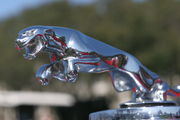
Jaguar, pronounced /ˈdʒæɡjuːər/ JAG-yew-ər (U.K.) or pronounced /ˈdʒæɡwɑr/ JAG-wahr (U.S.),[9] made its name in the 1950s with a series of elegantly styled sports cars and luxury saloons. In 1951 the company leased what would quickly become its principal plant from the Daimler Motor Company[10] (not to be confused with Daimler-Benz), and in 1960 purchased Daimler from its parent company, the Birmingham Small Arms Company (BSA). From the late 1960s, Daimler was used as a brand name for Jaguar's most luxurious saloons.[11]
British Leyland
Jaguar merged with the British Motor Corporation (BMC), the Austin-Morris combine, to form British Motor Holdings (BMH) in 1966. After merging with Leyland, which had already taken over Rover and Standard Triumph, the resultant company then became the British Leyland Motor Corporation (BLMC) in 1968. Financial difficulties and the publication of the Ryder Report led to effective nationalisation in 1975 and the company became British Leyland, Ltd. (later simply BL plc).[12]
In the 1970s the Jaguar and Daimler marques formed part of BL's specialist car division or Jaguar Rover Triumph Ltd until a restructure in the early 1980s saw most of the BL volume car manufacturing side becoming the Austin Rover Group within which Jaguar was not included. In 1984, Jaguar was floated off as a separate company on the stock market — one of the Thatcher government's many privatisations.[13]
Ford Motor Company era
The Ford Motor Company made offers to the US and UK Jaguar shareholders to buy their shares in November 1989; Jaguar's listing on the London Stock Exchange was removed on 28 February 1990.[14] In 1999 it became part of Ford's new Premier Automotive Group along with Aston Martin, Volvo Cars and, from 2000, Land Rover. Aston Martin was subsequently sold off in 2007. Between Ford purchasing Jaguar in 1989 and selling it in 2008 it did not earn any profit for the Dearborn-based auto manufacturer.
Since Land Rover's May 2000 purchase by Ford, it has been closely associated with Jaguar. In many countries they share a common sales and distribution network (including shared dealerships), and some models now share components, although the only shared production facility is Halewood, for the X-Type and the Freelander 2. However operationally the two companies were effectively integrated under a common management structure within Ford's PAG.
On 11 June 2007, Ford announced that it planned to sell Jaguar, along with Land Rover and retained the services of Goldman Sachs, Morgan Stanley and HSBC to advise it on the deal. The sale was initially expected to be announced by September 2007, but was delayed until March 2008. Private equity firms such as Alchemy Partners of the UK, TPG Capital, Ripplewood Holdings (which hired former Ford Europe executive Sir Nick Scheele to head its bid), Cerberus Capital Management and One Equity Partners (owned by JP Morgan Chase and managed by former Ford executive Jacques Nasser) of the US, Tata Motors of India and a consortium comprising Mahindra and Mahindra (an auto manufacturer from India) and Apollo Management all initially expressed interest in purchasing the marques from the Ford Motor Company.[15][16]
Before the sale was announced, Anthony Bamford, chairman of British excavator manufacturer JCB had expressed interest in purchasing the company in August 2006,[17] but backed out when told the sale would also involve Land Rover, which he did not wish to buy. On Christmas Eve of 2007, Mahindra and Mahindra backed out of the race for both brands, citing complexities in the deal.[18]
Modern era
On 1 January 2008, Ford made a formal announcement which declared Tata as the preferred bidder.[19] Tata Motors also received endorsements from the Transport And General Worker's Union (TGWU)-Amicus[20] combine as well as from Ford.[21] According to the rules of the auction process, this announcement would not automatically disqualify any other potential suitor. However, Ford (as well as representatives of Unite) would now be able to enter into more focused and detailed discussions with Tata to iron out issues ranging from labour concerns (job security and pensions), technology (IT systems and engine production) and intellectual property,[22] as well as the final sale price.[23] Ford would also open its books for a more comprehensive due diligence by Tata.[24] On 18 March 2008, Reuters reported that American bankers Citigroup and JP Morgan shall be underwriting a loan of USD 3 billion in order to finance the deal.[25]
On 26 March 2008, Ford announced that it had agreed to sell its Jaguar and Land Rover operations to Tata Motors of India, and that the sale was expected to be completed by the end of the second quarter of 2008.[26] Included in the deal were the rights to three other British brands, Jaguar's own Daimler, as well as two dormant brands Lanchester and Rover.[27] On 2 June 2008, the sale to Tata was completed at a cost of £1.7 billion.[28][29][30]
Assembly plant
The Swallow Sidecar company (SSC) was originally located in Blackpool but moved to Holbrook Lane, Coventry in 1928 when demand for the Austin Swallow became too great for the factory's capacity.[31] In 1951, having outgrown the original Coventry site they moved again to Browns Lane which had been a wartime "shadow factory" run by the Daimler Motor Company. Today, Jaguars are assembled at Castle Bromwich in Birmingham and Halewood in Liverpool. The historic Browns Lane plant ceased trim and final operations in 2005, the X350 XJ having already moved to Castle Bromwich two years prior, leaving the XK and S-Type production to Castle Bromwich and the X-Type at Halewood, alongside the new Land Rover Freelander 2, from 2007. A reduced Browns Lane site still operates today producing veneers for Jaguar Land Rover and others, as well as some engineering facilities.
Cars
Current models
XF (mid-size saloon), XJ (full-size saloon), XK (grand tourer)
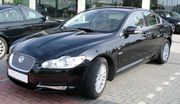
The Jaguar XF is a mid-size executive car that was introduced in 2008 to replace the out-going S-Type in the company's line-up. In January 2008, the XF was awarded the What Car? 'Car of the Year' and 'Executive Car of the Year' awards. The XF was also awarded Car of the Year 2008 from What Diesel? magazine. Engines available in the XF are a 3.0 litre V6 diesel or petrol and a 5.0 litre V8 supercharged called the XFR, or naturally aspirated V8 petrol, and - in the US - a 4.2L V8. Prices range from £29,900 to £62,600 in United Kingdom.[32]
The Jaguar XJ is a full-size luxury saloon and the company's flagship model. It has been in production since 1968 with the first generation being the last Jaguar car to have creative input by the company's founder, Sir William Lyons. In early 2003, the third generation XJ arrived in showrooms and while the car's exterior and interior styling were traditional in appearance, the car was completely re-engineered. Its styling attracted much criticism from many motoring journalists who claimed that the car looked old-fashioned and barely more modern than its predecessor, many even citing that the 'Lyons line' had been lost in the translation from Mark 2 into Mark 3 XJ, even though beneath the shell lied a highly advanced aluminium construction that put the XJ to very near the top of its class.[33]
Jaguar responded to the criticism with the introduction of the fourth generation XJ, launched in 2009. Its exterior styling is a departure from previous XJs, with a more youthful, contemporary stance, following the design shift that came into effect previously with the company's XF and XK models.[34]
The XJ is priced from £44,500 to £59,000 in United Kingdom with a sport model called the Super V8, starting at £50,000.[35] As the name suggests, the Super V8 features a supercharged 4.2 litre V8 engine, which accelerates the car from 0–60 mph (0–97 km/h) in just 5.0 seconds. To cater to the limousine market, all XJ models are offered with a longer wheelbase as an option, which enlarges the space available inside the cabin.[36]
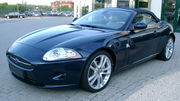
The Jaguar XK is a luxury grand tourer that was introduced in 2006, where it replaced the Jaguar XK8. The XK introduced an aluminium monocoque bodyshell, and is available both as a two-door coupé and two-door cabriolet/convertible. The XK price ranges from £60,000 - £71,000 in United Kingdom.[37]
R models
Jaguar began producing R models in 1995 with the introduction of the first XJR. Powered by a supercharged 6 cylinder engine, the car produced approximately 322 horsepower. With the revamped line of engines, the powerplant would be based on a 8 cylinder engine with supercharger from 1997 to present. The 1997-2003 XJR produced 370 horsepower (276 kW) and 385 pound-feet (522 N·m) of torque, taking the car to 60 mph (97 km/h) in just under 5.3 seconds. The new aluminium bodyshell from 2004–2009 and increased power to 400 hp (298 kW) and enhanced computer systems decreased the time to 60 mph (97 km/h) to a little over 5 seconds. Starting after year 2000, XJRs were equipped with Jaguar's CATS (Computer Active Technology Suspension) which helped firm up the ride in sporty driving without compromising the comfort during day to day use.
The first XKR was introduced in 1997 and kept with the same power increases as the XJR except for after 2006 the power in the XKR was boosted to 420 hp (313 kW). The S-Type R had a short production run from 2005–2007, and came equipped with the same 400 horsepower (298 kW) supercharged V8 as the other R models. It was replaced by the XFR, featuring a 5.0L supercharged V8 producing 510 horsepower.
- Jaguar XFR - mid-size saloon
- Jaguar XJR - full-size saloon
- Jaguar XKR - coupé and cabriolet
Past models
The Jaguar X-Type was a compact executive car launched in 2001, while the company was under Ford ownership. Sharing its platform with a 2000 Ford Mondeo, the X-Type lasted just one generation. The model ceased production in 2009 and is expected to be sold through the 2010 model year in its remaining markets.[38]
The Jaguar S-Type, which first appeared in 1999 and stopped production in 2008, was a retro version of Jaguar's beloved Mark series saloon of the 1960s. It was built on Ford DEW98 platform, which was shared by the retro Ford Thunderbird and the Lincoln LS. It has now been replaced by the Jaguar XF. Early S-Types suffered from reliability problems but those were mostly resolved by the 2004 model year.[39]
Historical models
The Jaguar company started production with the pre-war 1.5, 2.5 and 3.5 litre models which used engines designed by the Standard Motor Company. The 1.5 litre four-cylinder engine was still supplied by Standard but the two larger six-cylinder ones were made in house. These cars have become known unofficially as Mark IVs.
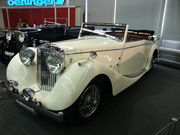
The first post war model was the 1948 Mark V available with either 2.5 or 3.5 litre engines and had a more streamlined appearance than pre-war models, but more important was the change to independent front suspension and hydraulic brakes.
The big breakthrough was the launch in 1948 of the XK120 sports car, which combined a body shell essentially copied from a 1940 BMW 328 Coupe with the new XK twin overhead camshaft (DOHC) 3.5 litre hemi-head six-cylinder engine designed by William Heynes, Walter Hassan and Claude Baily. This engine had been designed during the long nights during the war when they would be on fire watch in the factory. After several attempts a final design was arrived at. That is until owner William Lyons said "make it quieter". The car had originally been intended as a short production model of about 200 vehicles as a test bed for the new engine until its intended home, the new Mark VII saloon, was ready. The XK120's reception was such that production continued until 1954; it was followed by the XK140, the XK150, and the E-Type, keeping Jaguar in the sports car market.

Introducing the large Mark VII saloon in 1951, a car especially conceived for the American market, Jaguar soon found itself overwhelmed with orders. The Mark VII and its successors gathered rave reviews from magazines such as Road & Track and The Motor. In 1956 a Mark VII won the prestigious Monte Carlo Rally.
The 1955 Mark 1 small saloon was the first monocoque (unibody) car from Jaguar and used a 2.4 litre short stroke version of the XK engine. In 1959, the car was improved with a larger engine and wider windows and became the Mark 2, one of the most recognizable Jaguar models ever produced. It would be popular with British police forces for its small size, light weight, and powerful engine.
The Mark VIII of 1956 and Mark IX of 1958 were essentially updates of the Mark VII but the Mark X of 1961 was a completely new design of large saloon with all round independent suspension and unibody construction.
The independent rear suspension from the Mark X was incorporated in the 1963 S-Type which closely resembled the Mark 2, and in 1967 the Mark 2 name was dropped when the small saloon became the 240/340 range. The 420 of 1966, also sold as the Daimler Sovereign, put a new front onto the S-type, although both cars continued in parallel until the S-Type was dropped in 1968. The Mark X became the 420G in 1966.
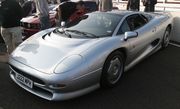
Of the more recent saloons, the most significant is the XJ (1968–present), still the definitive Jaguar saloon car for many. Since 1968 the Series I XJ has seen minor changes in 1973 (to Series II), 1979 (Series III), a complete redesign for 1986/1987 in XJ40, further modifications in 1995 (X300), in 1997 with V8-power (X308), and a major advance in 2003 with an industry-first aluminium monocoque-chassis (X350). The most luxurious XJ models carried either the Vanden Plas (US) or Daimler (rest of world) nameplates. In 1972 the 12 cylinder engine was introduced in the XJ, while simultaneously being offered in the E Type.
The XJ220 (1992–1994) held the world record for the highest top speed (350 km/h, 217 mph) of a production car.
Complete line-up
Large executive
- 1935–1948 2½ Litre saloon
- 1937–1948 3½ Litre saloon
- 1948–1951 Mark V
- 1951–1957 Mark VII (& VIIM)
- 1957–1959 Mark VIII
- 1959–1961 Mark IX
- 1961-1966 Mark X
- 1966-1970 420G
- 1968–1987 XJ6 Series 1, 2 & 3
- 1972–1992 XJ12
- 1986–1994 XJ6 (XJ40)
- 1993–1994 XJ12 (XJ81)
- 1995–1997 XJ6 & XJ12 (X300 & X301)
- 1998–2003 XJ8 (X308)
- 2004–2009 XJ (X350)
- 2009–date XJ (X351)
Compact executive
- 1935–1949 1½ Litre saloon
- 1955–1959 Mark 1
- 1959–1967 Mark 2
- 1963–1968 S-type
- 1966–1968 420
- 1966–1968 240 & 340
- 1999-2008 S-type
- 2001-date X-type
- 2008-date XF
Sports
- 1948–1954 XK120
- 1954–1957 XK140
- 1957–1961 XK150
- 1961–1974 E-Type
- 1975–1996 XJ-S
- 1992-1994 XJ220
- 1997–2005 XKR (X100)
- 1996–2006 Jaguar XK8 [40]
- 2007-date XKR (X150)
Racing and competition
- 1950s C-Type
- 1950s D-Type
- 1960s E-Type Lightweight
- 1985-1992 XJR-5 through XJR-15
- 2009 Bonneville 225.675 mph (363.189 km/h) XFR
_ret.jpg)
Concept models
- E1A - The 1950s E-Type concept vehicle
- E2A - The Second E-Type concept vehicle which was used at LeMans and for racing in USA
- Pirana (1967)
- XJ13 - Built to race at LeMans, never run
- XK180 (1998)
- F-Type (2000) – Roadster, similar to the XK8 but smaller
- R-Coupé (2002) – Luxury four-seater coupé, closest competitor being the Bentley Continental GT
- Fuore XF 10 (2003)
- R-D6 (2003) – Compact four-seat coupé
- XK-RR – A high-performance version of last generation XK coupé
- XK-RS – Another performance-spec version of last generation XK convertible
- Concept Eight (2004) – Super-luxury version of the long-wheelbase model of the XJ
- C-XF (2007)
Engines
Jaguar has designed in-house four generations of engines.
- Historical engines:
- Jaguar XK6 engine – inline-6
- Jaguar V12 engine – V12
- Jaguar AJ6 engine – inline-6
- Jaguar AJ16 engine- inline-6
- Current engines:
- Jaguar AJ-V8 engine – V8
- Jaguar AJ-V6 engine – V6
- Jaguar AJD-V6 engine - V6
Motorsport
- See also: Jaguar Racing and Jaguar XJR Sportscars
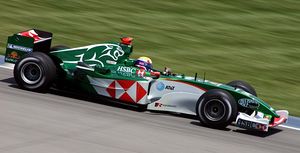
The company has had major success in sports car racing, particularly in the Le Mans 24 Hours. Victories came in 1951 and 1953 with the C-Type, then in 1955, 1956 and 1957 with the D-Type. The manager of the racing team during this period, Lofty England, later went on to become CEO of Jaguar in the early 1970s. Although the prototype XJ13 was built in the mid-1960s it was never raced, and the famous race was then left for many years, until in the mid-1980s when Tom Walkinshaw's TWR team started designing and preparing Jaguar V12-engined sports prototypes for European sports car races. The team started winning regularly from 1987, and with increased factory backing the team won Le Mans in 1988 and 1990.
In the 1999, Ford decided that Jaguar would be the corporation's Formula One entry. Ford bought out the Stewart Grand Prix team and rebranded it as Jaguar Racing for the 2000 season. The Jaguar F1 program was not a success however, achieving only two podium finishes in five seasons of competition between 2000 and 2004. At the end of 2004, with costs mounting and Ford's profits dwindling, the F1 team was seen as an unneeded expense and was sold to Red Bull energy drinks owner Dietrich Mateschitz, and it became Red Bull Racing. Since 2004 Jaguar has not had an official presence in motorsport.
Notable Jaguar sports racers:
- Jaguar C-Type (1951–1953)
- Jaguar D-Type (1954–1957)
- Jaguar Lightweight E-Type
- Jaguar XJR Sportscars
- Jaguar XJR-9 (1988)
- XJ220 (1988)
- XJR-15 (1990)
Media profile
- Inspector Morse (played by John Thaw) drives a 1960's Jaguar Mark series saloon in the long-running English television series based on novels by Colin Dexter.
- Sean Connery drove and largely wrecked a Jaguar XK during a scene in his 1999 movie, Entrapment.
Electric vehicles
Lotus Cars joined Jaguar and Caparo on a luxury hybrid executive sedan project called "Limo-Green" — funded by the UK Government Technology Strategy Board. The vehicle will be a series plug-in hybrid.[41]
References
- ↑ "Employee relations". Jaguar - Environmental and Social Reporting. https://jaguar.credit360.com/jaguar/site/page9.acds?context=980421&instanceid=980422. Retrieved 2009-07-03.
- ↑ "Tata Buys Jaguar Land Rover for $2.3 Billion". Autoblog.com. http://www.autoblog.com/2008/03/26/officially-official-tata-buys-jaguar-land-rover-for-2-3-billio/. Retrieved 2009-06-19.
- ↑ "The Years 1938 to 1953". Jaguar Cars Ltd.. http://www.jaguar.com/uk/en/company/overview/heritage/1938_1953.htm. Retrieved 2009-06-18.
- ↑ "The Years 1989 to 1986". Jaguar Cars Ltd.. http://www.jaguar.com/int/en/jaguar_ownership/company/heritage/1989_1996.htm. Retrieved 2009-06-19.
- ↑ "The Royal Warrant Holders ' Association - Directory of Royal Warrant Holders". http://www.royalwarrant.org/DirectorySQL.asp. Retrieved 2007-12-24.
- ↑ "The Years 1932 to 1935". Jaguar Cars Ltd.. http://www.jaguar.com/uk/en/company/overview/heritage/1932_1935.htm. Retrieved 2008-12-26.
- ↑ "The Years 1938 to 1953". Jaguar Cars Ltd.. http://www.jaguar.com/uk/en/company/overview/heritage/1938_1953.htm. Retrieved 2008-12-26.
- ↑ 8.0 8.1 "The Lyons share - interview with WL". Motor: pages 18–21. date 19 February 1972.
- ↑ Webster's New World Dictionary of the American Language. New York: World. 1962. p. 782.
- ↑ "75 Years of Daimler: A look back at one of the first car manufacturers in this country". Autocar 134 (nbr 3914): pages 16–19. date 1 April 1971.
- ↑ "The Years 1968 to 1979". Jaguar Cars Ltd.. http://www.jaguar.com/uk/en/company/overview/heritage/1968_1979.htm. Retrieved 2008-12-26.
- ↑ "The Ryder Report". Austin Rover Online. http://www.aronline.co.uk/index.htm?ryderreportf.htm. Retrieved 2008-12-26.
- ↑ Elliott, Larry (2000-11-22). "A whole world sold on sell-offs". London: The Guardian. http://www.guardian.co.uk/business/2000/nov/22/thatcher.politics1. Retrieved 2008-12-26.
- ↑ "The Years 1989 to 1996". Jaguar Cars Ltd.. http://www.jaguar.com/uk/en/company/overview/heritage/1989_1996.htm. Retrieved 2007-05-10.
- ↑ "India's Tata confirms interest in Land Rover, Jaguar". AFX News Ltd.. 24 August 2007. http://www.forbes.com/markets/feeds/afx/2007/08/24/afx4052453.html. Retrieved 2007-12-18.
- ↑ Clark, Nick (4 January 2008). "Tata in pole position to buy Jaguar and Land Rover marques from Ford". The Independent (London). http://news.independent.co.uk/business/news/article3307647.ece. Retrieved 2008-01-04.
- ↑ "JCB's Sir Anthony Bamford eyes Jaguar". Contract Journal. 24 August 2006. http://www.contractjournal.com/Articles/2006/08/24/51974/jcbs-sir-anthony-bamford-eyes-jaguar.html.
- ↑ Doval, Pankaj (24 December 2007). "M&M out of Jaguar, Land Rover race". Times News Network. http://timesofindia.indiatimes.com/MM_out_of_Jaguar_Land_Rover_race/articleshow/2646028.cms. Retrieved 2007-12-24.
- ↑ Krisher, Tom (3 January 2008). "Indian Company Top Bidder for Jaguar". Time. Associated Press. http://www.time.com/time/business/article/0,8599,1699920,00.html. Retrieved 2008-01-04.
- ↑ "Tata set to clinch Jaguar-Land Rover deal: Report". Press Trust of India. 20 December 2007. http://timesofindia.indiatimes.com/Tata_set_to_clinch_Jaguar-Land_Rover_deal_Report/articleshow/2637533.cms. Retrieved 2007-12-20.
- ↑ "Ford set to pick Jaguar frontrunner in days: source". Reuters. 17 December 2007. http://www.washingtonpost.com/wp-dyn/content/article/2007/12/17/AR2007121700620.html. Retrieved 2007-12-18.
- ↑ Ghosh, Suprotip (3 January 2008). "Super car technology headed for Tata stable". Hindustan Times. http://www.hindustantimes.com/StoryPage/StoryPage.aspx?id=287b0b39-fab7-4219-923a-d1fb409d8f25&ParentID=6c3b0942-84e5-4997-b350-794d54521614&MatchID1=4626&TeamID1=1&TeamID2=6&MatchType1=1&SeriesID1=1165&MatchID2=4618&TeamID3=3&TeamID4=4&MatchType2=1&SeriesID2=1163&PrimaryID=4626&Headline=Super+car+technology+headed+for+Tata+stable. Retrieved 2008-01-04.
- ↑ Leahy, Joe; Bernard Simon, Amy Yee (4 January 2008). "Tata falls for the attraction of opposites". Financial Times. http://www.ft.com/cms/s/0/9f884a00-ba68-11dc-abcb-0000779fd2ac.html. Retrieved 2008-01-04.
- ↑ "Ball now in Tata Motors’ court to tie-up deal: Unite". CNBC TV-18. 3 January 2008. http://www.moneycontrol.com/india/news/business/ball-nowtata-motors%E2%80%99-court-to-tie-up-deal-unite/22/39/319697. Retrieved 2008-01-04.
- ↑ "Tata gets $3 billion loan from Citi, JPMorgan: source". Reuters. 18 March 2008. http://www.hindustantimes.com/StoryPage/StoryPage.aspx?id=c0fba677-1cca-4a72-b13d-13e0a02747cc&&Headline=Tata+gets+%243+bln+loan+from+Citi%2c+JPMorgan%3a+source. Retrieved 2008-03-18.
- ↑ Ford Motor Company (2008-03-26). "FORD MOTOR COMPANY ANNOUNCES AGREEMENT TO SELL JAGUAR LAND ROVER TO TATA MOTORS". Press release. http://media.ford.com/newsroom/release_display.cfm?release=27953. Retrieved 2008-03-27.
- ↑ "5 for 2 special: Tata acquires 3 other British marques in Jaguar, Land Rover deal". Leftlane News. 28 March 2008. http://www.leftlanenews.com/5-for-2-special-tata-acquires-3-other-british-marques-in-jaguar-land-rover-deal.html#more-6922. Retrieved 2008-03-28.
- ↑ "Tata Motors completes acquisition of Jag, Land Rover". Thomson Reuters. 2 June 2008. http://www.reuters.com/article/ousiv/idUSBMA00084220080602. Retrieved 2008-06-02.
- ↑ "On U.S. tour, Mr. Tata gives Jaguar and Rover dealers a hug: AutoWeek Magazine". Autoweek.com. http://www.autoweek.com/apps/pbcs.dll/article?AID=/20080630/FREE/940478590/1528/newsletter01. Retrieved 2009-05-04.
- ↑ "Jobs warning at Jaguar Land Rover". BBC News. 2009-06-26. http://news.bbc.co.uk/1/hi/business/8121056.stm. Retrieved 2009-06-26.
- ↑ "Jaguar History". The Surrey Region Jaguar Enthusiasts Club. http://www.jaguar-enthusiasts.org.uk/jaguar-history.html.
- ↑ "Jaguar Cars UK Web Site". www.jaguar.co.uk. http://www.jaguar.com/gb/en/#/xf/models/xf_pricing. Retrieved 2010-05-24.
- ↑ "Jaguar XJ Series". Autocars.co.uk. http://www.autocar.co.uk/jaguar/xj-series/. Retrieved 2009-06-19.
- ↑ "Changing face of Jaguar". BBC News. 9 July 2009. http://news.bbc.co.uk/1/hi/england/west_midlands/8140482.stm. Retrieved 2009-07-15.
- ↑ "Jaguar XJ - New Car Data". carpages.co.uk. http://www.carpages.co.uk/guide/jaguar/jaguar-xj-guide.asp. Retrieved 2009-06-19.
- ↑ "Jaguar XJ - models". Jaguar Cars Ltd.. http://www.jaguar.co.uk/uk/en/xj/models_pricing/models/models.htm?route=_uk_en_xj_highlights_highlights_performance@__link__InfoBlockLink_3. Retrieved 2009-06-19.
- ↑ "Jaguar XK Guide". carpages.co.uk. http://www.carpages.co.uk/guide/jaguar/jaguar-xk-guide.asp. Retrieved 2010-05-16.
- ↑ Wearden, Graeme (2009-07-15). "300 jobs lost at Jaguar's Halewood plant". guardian.co.uk (London: Guardian News and Media). http://www.guardian.co.uk/business/2009/jul/15/halewood-jaguar-300-jobs-cut. Retrieved 2009-07-15.
- ↑ Consumer Reports, Buying Guide 2007, 211.
- ↑ "Jaguar XK8 | Used Car Tests | Car Reviews". Auto Express. 2006-12-05. http://www.autoexpress.co.uk/carreviews/usedcartests/204225/jaguar_xk8.html. Retrieved 2009-09-24.
- ↑ "Future Jaguar XJ May Cut CO2 Via Lotus 'LimoGreen' Project". Green Car Reports. 2009-02-20. http://www.greencarreports.com/blog/1018769_future-jaguar-xj-may-cut-co2-via-lotus-limogreen-project. Retrieved 2009-05-04.
External links
- Jaguar Cars official website
- Jaguar Cars YouTube channel
- Jaguar Cars at the Open Directory Project
- Comprehensive information on the Jaguar XKE
- Gallery and Video of Vintage Jaguar Cars
| Type | 1940s | 1950s | 1960s | 1970s | |||||||||||||||||||||||||||||||
| 5 | 6 | 7 | 8 | 9 | 0 | 1 | 2 | 3 | 4 | 5 | 6 | 7 | 8 | 9 | 0 | 1 | 2 | 3 | 4 | 5 | 6 | 7 | 8 | 9 | 0 | 1 | 2 | 3 | 4 | 5 | 6 | 7 | 8 | 9 | |
| Sports | XK120 | XK140 | XK150 | E-type S1 | E S2 | E-type S3 | XJ-S | ||||||||||||||||||||||||||||
| Saloon | Mark 1 | Mark 2, 240, 340 | |||||||||||||||||||||||||||||||||
| S-Type | XJ-C | ||||||||||||||||||||||||||||||||||
| 420 | XJ6 S1 | XJ6 S2 | |||||||||||||||||||||||||||||||||
| Mk IV | Mk V | Mk VII | Mk VIII | Mk IX | Mk X | 420G | XJ12 S1 | XJ12 S2 | |||||||||||||||||||||||||||
| Supercar | XKSS | ||||||||||||||||||||||||||||||||||
| Racing | C-Type | D-Type | E-Type | XJ13 | XJ-C | XJ41 / XJ42 | |||||||||||||||||||||||||||||
| Ownership | Independent | BMH | British Leyland | ||||||||||||||||||||||||||||||||
| Type | 1980s | 1990s | 2000s | 2010s | |||||||||||||||||||||||||||
| 0 | 1 | 2 | 3 | 4 | 5 | 6 | 7 | 8 | 9 | 0 | 1 | 2 | 3 | 4 | 5 | 6 | 7 | 8 | 9 | 0 | 1 | 2 | 3 | 4 | 5 | 6 | 7 | 8 | 9 | 0 | |
| Sports car | XJ-S | XJ-S HE | XJS | XK8 / XKR | XK / XKR | ||||||||||||||||||||||||||
| Compact exec | X-Type | ||||||||||||||||||||||||||||||
| Executive car | S-Type | XF/XFR | |||||||||||||||||||||||||||||
| Luxury | XJ6 S3 | XJ6 (XJ40) | XJ6 | XJ8 / XJR | XJ8 / XJR | XJ | |||||||||||||||||||||||||
| XJ12 S3 | XJ12 | XJ12 | |||||||||||||||||||||||||||||
| Halo model | 15 | XJ220 | |||||||||||||||||||||||||||||
| Racing | XJRs | C | R1/2/3/4/5 | XKR GT3/GT2 | |||||||||||||||||||||||||||
| Ownership | BL | Independent | Ford | Tata Motors | |||||||||||||||||||||||||||
|
|||||||||||||||||||||||||||||
| Marque | 1900s | 1910s | 1920s | 1930s | 1940s | 1950s | 1960s | 1970s | 1980s | 1990s | 2000s | 2010s | ||||||||||||||||||||||||||||||||||||||||||||||||
|---|---|---|---|---|---|---|---|---|---|---|---|---|---|---|---|---|---|---|---|---|---|---|---|---|---|---|---|---|---|---|---|---|---|---|---|---|---|---|---|---|---|---|---|---|---|---|---|---|---|---|---|---|---|---|---|---|---|---|---|---|
| Rolls-Royce | Rolls-Royce Limited | Rolls-Royce Limited & Bentley | Rolls-Royce Motors | Rolls-Royce Motors (Vickers) | BMW & VW Group | BMW | ||||||||||||||||||||||||||||||||||||||||||||||||||||||
| Bentley | Bentley | Volkswagen Group | ||||||||||||||||||||||||||||||||||||||||||||||||||||||||||
| Armstrong Siddeley | Siddeley-Deasy | Armstrong Whitworth | Armstrong Siddeley | Bristol Siddeley | Rolls-Royce Limited | Rolls-Royce plc | ||||||||||||||||||||||||||||||||||||||||||||||||||||||
| Aston Martin | Aston Martin | Aston Martin Lagonda | Ford PAG | Aston Martin Lagonda | ||||||||||||||||||||||||||||||||||||||||||||||||||||||||
| Lagonda | Lagonda | |||||||||||||||||||||||||||||||||||||||||||||||||||||||||||
| Jaguar | SS Cars | Jaguar | Jaguar & Daimler |
BMH | BLMC / British Leyland | Jaguar & Daimler |
Ford PAG | Tata | ||||||||||||||||||||||||||||||||||||||||||||||||||||
| Daimler | Daimler | BSA | BSA | |||||||||||||||||||||||||||||||||||||||||||||||||||||||||
| Lanchester | Lanchester | |||||||||||||||||||||||||||||||||||||||||||||||||||||||||||
| Rover | Rover | Rover | Rover | Austin Rover Group & Land Rover Group (BL plc) |
Rover Group (BAe) | Rover Group (BMW) |
MG Rover Group (PVH) | |||||||||||||||||||||||||||||||||||||||||||||||||||||
| Land Rover | Ford PAG | |||||||||||||||||||||||||||||||||||||||||||||||||||||||||||
| Alvis | Alvis | BAE Systems | ||||||||||||||||||||||||||||||||||||||||||||||||||||||||||
| Standard | Standard | Standard Triumph | Leyland Motors | British Motor Heritage | ||||||||||||||||||||||||||||||||||||||||||||||||||||||||
| Triumph | Dawson | Triumph | BMW | |||||||||||||||||||||||||||||||||||||||||||||||||||||||||
| Riley | Riley | Nuffield Organisation | BMC | BMH | ||||||||||||||||||||||||||||||||||||||||||||||||||||||||
| MG | Morris Garages (MG) | Rover Group (BMW) |
MG Rover Group (PVH) | SAIC & NAC |
SAIC | |||||||||||||||||||||||||||||||||||||||||||||||||||||||
| Morris | Morris | Morris | ||||||||||||||||||||||||||||||||||||||||||||||||||||||||||
| Wolseley | Wolseley | |||||||||||||||||||||||||||||||||||||||||||||||||||||||||||
| Austin | Austin | Austin | ||||||||||||||||||||||||||||||||||||||||||||||||||||||||||
| Vanden Plas | Vanden Plas | |||||||||||||||||||||||||||||||||||||||||||||||||||||||||||
| Mini | Mini (BMW) | |||||||||||||||||||||||||||||||||||||||||||||||||||||||||||
| Austin-Healey | Austin (BMC) & Donald Healey | |||||||||||||||||||||||||||||||||||||||||||||||||||||||||||
| Jensen | Jensen Motors | Britcar Holdings | Jensen Cars | |||||||||||||||||||||||||||||||||||||||||||||||||||||||||
| Reliant | Reliant | Reliant | ||||||||||||||||||||||||||||||||||||||||||||||||||||||||||
| Bond | Bond | |||||||||||||||||||||||||||||||||||||||||||||||||||||||||||
| AC | AC Cars (several ownership & company name changes) | |||||||||||||||||||||||||||||||||||||||||||||||||||||||||||
| Argyll | Argyll | Argyll | ||||||||||||||||||||||||||||||||||||||||||||||||||||||||||
| Bristol Cars | Bristol Cars | |||||||||||||||||||||||||||||||||||||||||||||||||||||||||||
| Caterham | Caterham | |||||||||||||||||||||||||||||||||||||||||||||||||||||||||||
| Crossley | Crossley | |||||||||||||||||||||||||||||||||||||||||||||||||||||||||||
| Dutton | Dutton | Dutton | ||||||||||||||||||||||||||||||||||||||||||||||||||||||||||
| Ginetta | Ginetta | |||||||||||||||||||||||||||||||||||||||||||||||||||||||||||
| Gordon-Keeble | Peerless & Warwick | Gordon-Keeble | ||||||||||||||||||||||||||||||||||||||||||||||||||||||||||
| Jowett | Jowett | Blackburn | ||||||||||||||||||||||||||||||||||||||||||||||||||||||||||
| Lea-Francis | Lea-Francis | |||||||||||||||||||||||||||||||||||||||||||||||||||||||||||
| Lotus | Lotus | General Motors Europe | Proton | |||||||||||||||||||||||||||||||||||||||||||||||||||||||||
| McLaren | McLaren | |||||||||||||||||||||||||||||||||||||||||||||||||||||||||||
| Marcos | Marcos | Marcos | Marcos | |||||||||||||||||||||||||||||||||||||||||||||||||||||||||
| Morgan | Morgan | |||||||||||||||||||||||||||||||||||||||||||||||||||||||||||
| Napier | Napier | |||||||||||||||||||||||||||||||||||||||||||||||||||||||||||
| Turner | Turner | |||||||||||||||||||||||||||||||||||||||||||||||||||||||||||
| TVR | TVR | |||||||||||||||||||||||||||||||||||||||||||||||||||||||||||
| Westfield | Westfield | Potenza Sports Cars | ||||||||||||||||||||||||||||||||||||||||||||||||||||||||||
| GTM | GTM | |||||||||||||||||||||||||||||||||||||||||||||||||||||||||||
| Vauxhall | Vauxhall Motors | General Motors | General Motors Europe | |||||||||||||||||||||||||||||||||||||||||||||||||||||||||
| Vulcan | Vulcan | |||||||||||||||||||||||||||||||||||||||||||||||||||||||||||
| Hillman | Hillman | Humber | Rootes | Chrysler Europe (Chrysler) | Peugeot (PSA) | |||||||||||||||||||||||||||||||||||||||||||||||||||||||
| Humber | Humber | |||||||||||||||||||||||||||||||||||||||||||||||||||||||||||
| Singer | Singer | Rootes | ||||||||||||||||||||||||||||||||||||||||||||||||||||||||||
| Sunbeam | Sunbeam | Sunbeam-Talbot-Darracq | Rootes | (as Sunbeam-Talbot) Rootes | Rootes | |||||||||||||||||||||||||||||||||||||||||||||||||||||||
| Talbot | Talbot | |||||||||||||||||||||||||||||||||||||||||||||||||||||||||||
| Marque | 1900s | 1910s | 1920s | 1930s | 1940s | 1950s | 1960s | 1970s | 1980s | 1990s | 2000s | 2010s | ||||||||||||||||||||||||||||||||||||||||||||||||
| Marque | 1900s | 1910s | 1920s | 1930s | 1940s | 1950s | 1960s | 1970s | 1980s | 1990s | 2000s | 2010s | |||||||||||||||||||||||||||||||||||||||||||||||||
|---|---|---|---|---|---|---|---|---|---|---|---|---|---|---|---|---|---|---|---|---|---|---|---|---|---|---|---|---|---|---|---|---|---|---|---|---|---|---|---|---|---|---|---|---|---|---|---|---|---|---|---|---|---|---|---|---|---|---|---|---|---|
| Jaguar | SS Cars | Jaguar | Jaguar & Daimler |
BMH | BLMC / British Leyland | Jaguar & Daimler |
Ford PAG | Tata | |||||||||||||||||||||||||||||||||||||||||||||||||||||
| Daimler | Daimler | BSA | BSA | ||||||||||||||||||||||||||||||||||||||||||||||||||||||||||
| Lanchester | Lanchester | ||||||||||||||||||||||||||||||||||||||||||||||||||||||||||||
| Rover | Rover | Rover | Rover | Austin Rover Group & Land Rover Group (BL plc) |
Rover Group (BAe) | Rover Group (BMW) |
MG Rover Group (PVH) | ||||||||||||||||||||||||||||||||||||||||||||||||||||||
| Land Rover | Ford PAG | ||||||||||||||||||||||||||||||||||||||||||||||||||||||||||||
| Alvis | Alvis | BAE Systems | |||||||||||||||||||||||||||||||||||||||||||||||||||||||||||
| Standard | Standard | Standard Triumph | Leyland Motors | British Motor Heritage | |||||||||||||||||||||||||||||||||||||||||||||||||||||||||
| Triumph | Dawson | Triumph | BMW | ||||||||||||||||||||||||||||||||||||||||||||||||||||||||||
| Riley | Riley | Nuffield Organisation | BMC | BMH | |||||||||||||||||||||||||||||||||||||||||||||||||||||||||
| MG | Morris Garages (MG) | Rover Group (BMW) |
MG Rover Group (PVH) | SAIC & NAC |
SAIC | ||||||||||||||||||||||||||||||||||||||||||||||||||||||||
| Morris | Morris | Morris | |||||||||||||||||||||||||||||||||||||||||||||||||||||||||||
| Wolseley | Wolseley | ||||||||||||||||||||||||||||||||||||||||||||||||||||||||||||
| Austin | Austin | Austin | |||||||||||||||||||||||||||||||||||||||||||||||||||||||||||
| Vanden Plas | Vanden Plas | ||||||||||||||||||||||||||||||||||||||||||||||||||||||||||||
| Mini | Mini (BMW) | ||||||||||||||||||||||||||||||||||||||||||||||||||||||||||||
| Austin-Healey | Austin (BMC) & Donald Healey | ||||||||||||||||||||||||||||||||||||||||||||||||||||||||||||
| Marque | 1900s | 1910s | 1920s | 1930s | 1940s | 1950s | 1960s | 1970s | 1980s | 1990s | 2000s | 2010s | |||||||||||||||||||||||||||||||||||||||||||||||||